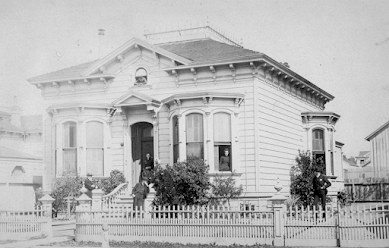 |
| Giulio Minetti and Grave Marker |
De Fremery Family - Plot 8
Giulio Minetti was an Italian-American violist, conductor, and prominent figure in the early musical life of San Francisco. He played a key role in the development of orchestral performance in California in the late 19th and early 20th centuries.
Minetti was born on November 22, 1866, in Turin, Italy. Trained in the European classical tradition, he emigrated to the United States in 1891, arriving in New York aboard the vessel La Normandie before settling in San Francisco. His arrival coincided with the city’s growing appetite for professional musical performance and culture. He remained lifelong friends with his Italian classmate and colleague, conductor Arturo Toscanini.
Shortly after arriving in San Francisco, Minetti quickly established himself as a sought-after violist and conductor. He was an early and leading member of the San Francisco Symphony Orchestra, an ensemble founded in 1881 by German conductor Fritz Scheel. This orchestra should not be confused with today’s San Francisco Symphony, which was founded in 1911 under Henry Hadley. The earlier organization in which Minetti was involved dissolved around 1906 and served more as a semi-professional or ad hoc orchestral society, often assembled for touring European conductors or civic occasions.
 |
| Concert Ad and Minetti Headshot |
In 1912, Minetti married Alice Frances de Fremery, a member of one of Oakland’s most prominent families. The de Fremery family was deeply involved in civic and philanthropic affairs, and their estate later became DeFremery Park in West Oakland. The marriage further embedded Minetti in the East Bay’s social and cultural circles.
Minetti’s public career came to an abrupt end in early 1930 when he was accused of misconduct involving a female music student. The incident was reported in local newspapers, including the Berkeley Daily Gazette on January 6, 1930, but the student’s name was not disclosed. Although the case was dismissed for lack of evidence and no formal charges were pursued, the episode tarnished his reputation and effectively ended his work as a public conductor and music teacher. Following the scandal, Minetti withdrew from professional life and lived in relative obscurity until his death.
Giulio Minetti died on March 31, 1958, in Berkeley, California, at the age of 91. His funeral was held at St. Augustine’s Church in Oakland, and he was interred at Mountain View Cemetery in the De Fremery family plot. At the time of his death, he was remembered as a pioneering figure in California’s early symphonic culture and one of the few remaining links to San Francisco’s pre-earthquake musical elite.
Sources: The San Francisco Call (June 9, 1912; July 19, 1896), the Berkeley Daily Gazette (January 6, 1930), the Oakland Tribune and Bakersfield Californian obituaries (both April 1, 1958), and the San Francisco Public Library Art, Music and Recreation Center’s profile on Giulio Minetti.



















